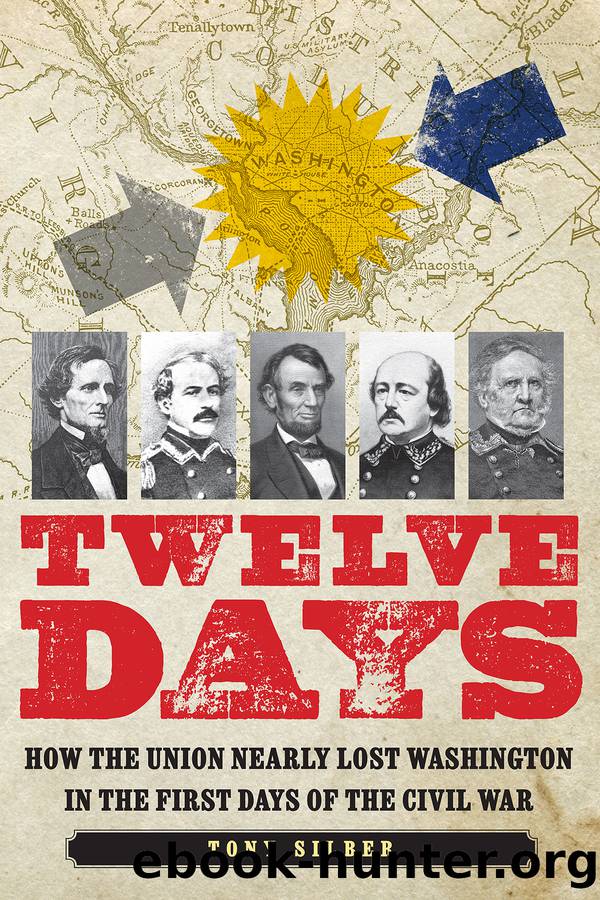Twelve Days: How the Union Nearly Lost Washington in the First Days of the Civil War by Tony Silber

Author:Tony Silber [Silber, Tony]
Language: eng
Format: epub
Tags: HIS036050 HISTORY / United States / Civil War Period (1850-1877)
Publisher: Potomac Books
18
A Northern Convoy Departs
Annapolis
The steam ferry Maryland, with the Eighth Massachusetts aboard, arrived at Annapolis soon after midnight early Sunday morning, the twenty-first, following a six-hour voyage down the Chesapeake Bay. The most excitement that evening turned out to be the growling of sleepy men when Gen. Benjamin F. Butler accidentally stepped on them.
Annapolis was an old city, founded by Puritan exiles from Virginia in 1649. It became the Maryland colonial capital in 1695, and its statehouse, built in 1792, is the oldest capitol in the United States in continuous legislative use.
Once intended as a port of entry for Washington DC, Annapolis eventually lost the shipping trade to Baltimore, and now, in 1861, it was a quiet city of about 4,529 people, including 826 free Black people and 475 enslaved people.1
Annapolis was about a mile up the Severn River from the bay. The Naval Academy, founded as the âNaval Schoolâ on a former army installation in 1845, was on the river, with the city beyond its walls. Butler expected the town to be asleep on this balmy evening. Instead, he found alarm. Drummers on the academy grounds were beating the âassembly,â calling men to rendezvous points. Lights were moving around rapidly on shore. The buildings were lit up.
The Maryland was anchored and waited. It was a dark night, and Butlerâs plan was to go ashore in the morning. But he decided to send someone out to see what was happening and deliver a note to the naval schoolâs superintendent. Butlerâs brother, Andrew, in civilian clothes, volunteered. His boat slipped off into the black night.2
After about an hour, the men on the Maryland heard oars lapping in the water and then saw a boat approaching with five people, none of whom were Andrew Butler.
âWhat boat is that?â Butler cried out.
âWhat steamer is that?â came the reply.
Butler feared the naval academy had fallen to the insurrectionists. âNone of your business. Come alongside, or I will fire into you.â
A young officer in a U.S. Navy uniform climbed aboard. He was sent by the academyâs superintendent, Capt. George S. Blake. He asked again who was on the steamer. Butler explained that he was from Massachusetts, with a militia regiment on its way to Washington.
The officer, Lt. Cdr. Edmond O. Matthews, an assistant to the commandant of midshipmen, was relieved. He told Butler that Blake feared the Maryland had been commandeered by Baltimore âroughsâ and was coming to seize the academy.3
At daybreak the contours of the city and the academy began to emerge. On the southern (or left) bank was the academy, dominated by Fort Severn, a circular masonry structure enclosed by a fourteen-foot stone wall. Beyond the fort were barracks and academic buildings. In 1861 the most prominent feature of the academy, other than the fort, was a line of buildings called Stribling Row, which ran parallel to the river and consisted of red brick buildings with slate roofs. Beyond the academy, the state capitol rose on a hill above the town.4
Just as the sun was coming up, a boat arrived at the Maryland carrying the superintendent, Captain Blake.
Download
This site does not store any files on its server. We only index and link to content provided by other sites. Please contact the content providers to delete copyright contents if any and email us, we'll remove relevant links or contents immediately.
| United States | Abolition |
| Campaigns & Battlefields | Confederacy |
| Naval Operations | Regimental Histories |
| Women |
In Cold Blood by Truman Capote(3348)
The Innovators: How a Group of Hackers, Geniuses, and Geeks Created the Digital Revolution by Walter Isaacson(3006)
Steve Jobs by Walter Isaacson(2863)
All the President's Men by Carl Bernstein & Bob Woodward(2347)
Lonely Planet New York City by Lonely Planet(2199)
And the Band Played On by Randy Shilts(2169)
The Room Where It Happened by John Bolton;(2135)
The Poisoner's Handbook by Deborah Blum(2112)
The Murder of Marilyn Monroe by Jay Margolis(2080)
The Innovators by Walter Isaacson(2076)
Lincoln by David Herbert Donald(1967)
A Colony in a Nation by Chris Hayes(1905)
Being George Washington by Beck Glenn(1784)
Under the Banner of Heaven: A Story of Violent Faith by Jon Krakauer(1768)
Amelia Earhart by Doris L. Rich(1670)
The Unsettlers by Mark Sundeen(1660)
Dirt by Bill Buford(1651)
Birdmen by Lawrence Goldstone(1641)
Zeitoun by Dave Eggers(1622)
